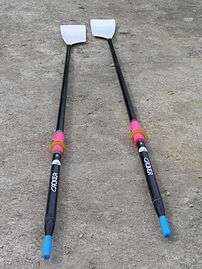Oar (sport rowing)

In rowing, oars are used to propel the boat. Oars differ from paddles in that they use a fixed fulcrum, an oarlock attached to the side of the boat, to transfer power from the handle to the blade, rather than using the athlete's shoulders or hands as the pivot-point as in canoeing and kayaking.
When the rower uses one oar on one side, it is called sweep rowing that the single oar is called a "sweep" oar.[1] When the rower uses two oars at the same time, one on each side, it is called sculling, and the two oars are called a pair of "sculls". Typical sculls are around 284 cm - 290 cm in length — sweep oars are 370 cm - 376 cm. A scull has a smaller blade area, as each rower wields a pair of them at any one time, operating each with one hand. Since the 1980s many oars have been adjustable in length.
The shaft of the oar ends with a thin flat surface 40 to 50 cm long and 25 cm wide, variously called the blade or spoon. Further along are the loom (or shaft), 2/3 of the way up which is the sleeve (including a wearplate) and button (or collar), and at the very end the handle. The handle may revert to wooden or, particularly in the case of sculls and some 21st century models of sweep-oar blades have rubber, cellular foam, suede or for example wood veneer grips over glass fiber.
The part of the oar the rower holds while rowing is the handle which is longer for sweep blades as each is held using both hands, than for sculls which are held with one hand.
There are hundreds of different variations of oars in terms of size and manufacturer specifications. "Macon" or "Cleaver" blade shapes of carbon-fibre are the most common in modern-day rowing. Classic oars were made out of wood. Since the use of such synthetic materials, first mass-produced by Dreissigacker in 1975,[2] the weight of an oar has come down from over 7 kg to less than 2.5 kg and 1.275-1.8 kg in the case of sculls.[3] While rowing in the most common competitive boats, fine boats (racing shells), oars are since the early part of the 20th century supported by metal or fibreglass frames attached to the side of the boat called riggers for extra leverage.
Blade shapes
Cleaver
The most common shape now seen is the "cleaver" (also called "hatchet"), which is used almost universally. Cleaver blades are asymmetrical, with a somewhat rectangular shape resembling a meat cleaver, hence the name. The shaft of a cleaver blade connects to the blade offset to the top corner of the blade. The shape of the face and the offset connection is designed to maximize the surface area of the blade in contact with the water during the rowing stroke, while also minimizing the amount and depth of the shaft that is submerged and contributing to drag. As the cleaver blade is asymmetrical it may only be used on one side of the boat or the other.
Cleaver blade designs were first developed by Dick and Pete Dreissigacker in 1991.[4] They are now manufactured by most major rowing oar suppliers, including Concept 2 and Croker.

Macon
Some clubs use the older "macon" style blades (also called "spoons" or "tulips" or "shovels") for novice crews, usually to develop the basic technique of the rower without the extra complexity of a cleaver blade. A minority of coaches favor macons, but it has been generally accepted since their introduction in 1992 that cleavers give a speed advantage over macons under most conditions.
Macon blades are symmetrical, with an elliptical shape and a ridgeline running down the center of the blade face. The blade is squared off at the end. Despite the blade being symmetrical, modern asymmetrical collars or aesthetic issues regarding decorative paint on the blade face may dictate which side of the boat the blade can be rowed on.
Macon blades achieved prominence at the 1959 European Championship in Mâcon when they were used by the West German national team. West Germany won all the male sweep events that year, except the coxless four.
Square
Prior to the development of the macon blade a longer, thinner shape was used, known as "square" blades or "standard" blades. They are still occasionally used in training for technique.
The development from standard to cleaver, via the macon, is therefore a progression from long, thin blades to shorter, wider ones. In each case there has been a reduction in the area of the blade that actually moves the wrong way through the water: in practice a point of the blade remains stationary relative to the water, with the portion outboard of that point providing drive, and the area inboard of it providing drag. Shorter, wider blades place this pivot point closer to the blade's neck, reducing the area dragging in the water.
See also
References
- ↑
- ↑ Oar Brochure, timeline on page 2 Guide to sculls and sweep blades from mass-manufacturer Concept 2, Retrieved 2016-03-28
- ↑ Croker blades specifications Scull specifications from mass manufacturer Croker. Retrieved 2016-03-28.
- ↑ "RowHist-Equipment". Rowinghistory.net. Retrieved 2016-08-03.